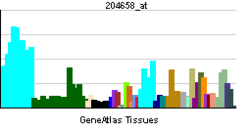TRA2A
Transformer-2 protein homolog alpha is a protein that in humans is encoded by the TRA2A gene.[3][4][5]
This gene is a member of the transformer 2 homolog family and encodes a protein with two RS domains and an RRM (RNA recognition motif) domain. This phosphorylated nuclear protein binds to specific RNA sequences and plays a role in the regulation of pre-mRNA splicing. Several alternatively spliced transcript variants of this gene have been described; however, the full-length nature of some of these variants has not been determined.[5]
References
Further reading
- "Toward a complete human genome sequence.". Genome Res. 8 (11): 1097–108. 1999. doi:10.1101/gr.8.11.1097. PMID 9847074.
- Strausberg RL, Feingold EA, Grouse LH, et al. (2003). "Generation and initial analysis of more than 15,000 full-length human and mouse cDNA sequences.". Proc. Natl. Acad. Sci. U.S.A. 99 (26): 16899–903. doi:10.1073/pnas.242603899. PMC 139241
 . PMID 12477932.
. PMID 12477932.
- Matsuda A, Suzuki Y, Honda G, et al. (2003). "Large-scale identification and characterization of human genes that activate NF-kappaB and MAPK signaling pathways.". Oncogene. 22 (21): 3307–18. doi:10.1038/sj.onc.1206406. PMID 12761501.
- Shin C, Feng Y, Manley JL (2004). "Dephosphorylated SRp38 acts as a splicing repressor in response to heat shock.". Nature. 427 (6974): 553–8. doi:10.1038/nature02288. PMID 14765198.
- Jin J, Smith FD, Stark C, et al. (2004). "Proteomic, functional, and domain-based analysis of in vivo 14-3-3 binding proteins involved in cytoskeletal regulation and cellular organization.". Curr. Biol. 14 (16): 1436–50. doi:10.1016/j.cub.2004.07.051. PMID 15324660.
- Gerhard DS, Wagner L, Feingold EA, et al. (2004). "The status, quality, and expansion of the NIH full-length cDNA project: the Mammalian Gene Collection (MGC).". Genome Res. 14 (10B): 2121–7. doi:10.1101/gr.2596504. PMC 528928
 . PMID 15489334.
. PMID 15489334.
- Gevaert K, Staes A, Van Damme J, et al. (2006). "Global phosphoproteome analysis on human HepG2 hepatocytes using reversed-phase diagonal LC.". Proteomics. 5 (14): 3589–99. doi:10.1002/pmic.200401217. PMID 16097034.
- Rual JF, Venkatesan K, Hao T, et al. (2005). "Towards a proteome-scale map of the human protein-protein interaction network.". Nature. 437 (7062): 1173–8. doi:10.1038/nature04209. PMID 16189514.
- Beausoleil SA, Villén J, Gerber SA, et al. (2006). "A probability-based approach for high-throughput protein phosphorylation analysis and site localization.". Nat. Biotechnol. 24 (10): 1285–92. doi:10.1038/nbt1240. PMID 16964243.
- Olsen JV, Blagoev B, Gnad F, et al. (2006). "Global, in vivo, and site-specific phosphorylation dynamics in signaling networks.". Cell. 127 (3): 635–48. doi:10.1016/j.cell.2006.09.026. PMID 17081983.

 . PMID 8799144.
. PMID 8799144. . PMID 12477932.
. PMID 12477932. . PMID 15489334.
. PMID 15489334.